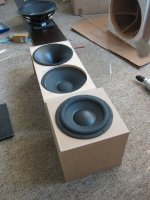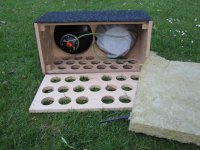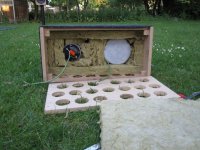There was a good discussion about this on HTguide.com when Augerpro was building a two. I will try and find it. We also rear mounted our woofers to try and get the AC closer together.
I considered rear-mounting of the woofer and I actually started building the speaker with such a configuration, but I didn't like the way it looked (heck, I've even got a picture of it!), so I built a new baffle with the woofer on the front.
It was indeed a bit more difficult than usual to get the crossover right, but I think in the end it turned out pretty well.
I'll have a look at the thread at HTGuide!
Attachments
I used a 3/4" round over to make it look a little better.
btw, Great pictures, Great build! Its nice to read that you had some experienced listeners over for a listen and they liked it! Its important for others to listen. Im stuck with friends and family that do not really care about differences in audio. They tend to say, "Yep, that sounds great" 😀
btw, Great pictures, Great build! Its nice to read that you had some experienced listeners over for a listen and they liked it! Its important for others to listen. Im stuck with friends and family that do not really care about differences in audio. They tend to say, "Yep, that sounds great" 😀
Member
Joined 2009
Last saturday I threw a party to celebrate my birthday.
Congratulations! Sounds like you gave yourself an awesome birthday present.
Are you running the open back 12" down to the lowest frequency? May I suggest you explore having a regular monopole sub at the bottom. The cardioid response already has a wide dispersion that looks like it may transition well to a monopole. I don't know if this will work, I'm only suggesting. A sub should give you enough power on the low end to not worry about the 8dB gain.
Hi Boris,
Thanks!
The front speakers are highpassed at 100 hz and I'm already using multiple subs. They are a combination of passive radiator subs and a closed one. They match pretty well with the fronts. I think directivity doesn't matter much anymore below about 300 hz and I could probably get away with a higher crossoverpoint for speakers and the subs that stand right beside each one of them. That way I could increase dynamic range. But to be honest, I don't think that's necessary. The system already goes crazy loud!
Thanks!
The front speakers are highpassed at 100 hz and I'm already using multiple subs. They are a combination of passive radiator subs and a closed one. They match pretty well with the fronts. I think directivity doesn't matter much anymore below about 300 hz and I could probably get away with a higher crossoverpoint for speakers and the subs that stand right beside each one of them. That way I could increase dynamic range. But to be honest, I don't think that's necessary. The system already goes crazy loud!
Cool project that will be very interesting to follow
Q1: Can the design be concidered as a OB with a low pass filter for the higher back radiating frequencies?
Q2: Do you gain any increase in capacity at the lower frequencies compared to a normal dipol mount?
Best Regards
Q1: Can the design be concidered as a OB with a low pass filter for the higher back radiating frequencies?
Q2: Do you gain any increase in capacity at the lower frequencies compared to a normal dipol mount?
Best Regards
Cool project that will be very interesting to follow
Q1: Can the design be concidered as a OB with a low pass filter for the higher back radiating frequencies?
Q2: Do you gain any increase in capacity at the lower frequencies compared to a normal dipol mount?
Best Regards
Hi Tytte71,
In this picture you can see the woofer response a 0 degrees and 180 degrees (gated, 1/24 oct. smoothing).
An externally hosted image should be here but it was not working when we last tested it.
It's difficult to say exactly what's going on, because several mechanisms are at play here.
- Driver directivity.
- Baffle- and box-shape influences.
- Interference of front- and rear-radiation
- Low-passed rear radiation of the woofer due to motor-structure.
- Low-passed rear radiation of the woofer due to damping material.
- Delay of the rear-wave due to damping material.
An externally hosted image should be here but it was not working when we last tested it.
Directivity Sonogram, ungateda 1/6 oct. smoothing.
It is evident that the damping material still has some effect at lower frequencies. Between 100 and 200 hz it looks a bit like a super-cardioid. Between 200 and about 500 hz things look a bit messy while the dispersion widens a bit, but at least directivity is greater than that of a similarly sized closed box. At higher frequencies things don't look much different than a conventional box, although there may be slightly greater directivity.
What is gained compared to a closed box is the less rapidly changing and thus more constant directivity. Compare to for instance the Gedlee Abbey (currently considered the state of the art by many):

Is the better controlled directivity in the lower midrange of my speaker audible? I'm sure it doesn't hurt, but I don't know if it sounds better.
This greater directivity comes at the cost of efficiency. Efficiency in the lower frequencies is probably not much different than if it were a dipole, but the radiation pattern is. I haven't done a direct comparison between with and without the damping material, so I can't tell you for sure.
Thanks that was very informative.
Looking at the songram and its irregularities between 200-500Hz, could this have something to do with the perforated cabinet that you use (caused by reflections and diffractions)?
Have you tried using the same damping material wrapped around the back of a nude driver to see if this create a more uniform response? And would this lead to loss in any properties below 200 and above 500Hz?
Best Regards
Looking at the songram and its irregularities between 200-500Hz, could this have something to do with the perforated cabinet that you use (caused by reflections and diffractions)?
Have you tried using the same damping material wrapped around the back of a nude driver to see if this create a more uniform response? And would this lead to loss in any properties below 200 and above 500Hz?
Best Regards
Hope you will excuse me for nagging, but it would be very nice to also see a sonogram for vertical axis and impuls respons for the mid 🙂
Keyser, I love your work. Many custom studio monitors follow this general concept. I wonder how much better yours would be with an active crossover and dedicated amps. Also, why not line the inside of the box with an absorptive layer? A mesh of sorts, appropriately tensioned, would allow you to do the same for the back without sacrificing the cardioid concept.
I did make the same a dipool to gather with the kugelwellen horn.http://www.diyaudio.com/forums/multi-way/189250-kugelwellen-horn.html it a XXL version of your design.I’d like to hear what you guys think!
Some observations that I find interesting and which might be worth a discussion:
- The ugly looking high frequency response doesn't sound half as ugly as it looks. This may have to do with the critical bandwidth of the auditory system.
- The unfiltered response of the CD-waveguide combo doesn't have the expected downward trend. A downward trend corresponds with more or less constant directivity. Personally I wouldn't call the directivity of this combo constant(at least not as constant as is attainable with dipoles with minimum baffle), but it's not really less constant than that of other speakers that their designers do call Constant Directivity. Why is the on-axis response relatively flat?
- There is no on-axis dip anywhere. Does this mean this combination creates a lot of HOM? If so:
- Don't HOM primarily harm the highest frequencies? If so, then I don't understand, because the highs sound very clean. If there is one thing I don't like about them, it is perhaps that they sound a bit less spacious than the highs of wider dispersion speakers.
- At higher levels the midrange becomes a bit shouty on some material. Do you guys things this is caused by some kind of horn distortion, or maybe be the rather lively room they are in? Another possibility is the EQ that may not yet be topnotch.
About the HF response is probably a not optimal coupling with the horn entry. Personal I think only the level of frequencies above 10kHz are detectable for humans, phase does not matter here.
Detail for human-hearing is made some where around 200-10000kHz so there it has to be as accurate possible to get microdetailed sound.
This one could look better.
Measure the minimum phase the 180 to -180 does not show very well the phase to compare results. Choose in view minimum phase.
measure to close to the speaker with microphone between the woofer and the wave guide so they have both the same distance you will understand I know.
An externally hosted image should be here but it was not working when we last tested it.
Measure the minimum phase the 180 to -180 does not show very well the phase to compare results. Choose in view minimum phase.
measure to close to the speaker with microphone between the woofer and the wave guide so they have both the same distance you will understand I know.
Helmuth,
I'm not using the calculated minimum phase because I want to take the delay difference into the measurement. This looks a bit messier, but it's easier to work with.
I'm not using the calculated minimum phase because I want to take the delay difference into the measurement. This looks a bit messier, but it's easier to work with.
Hello Keyser,
Do you have some pictures about the stuffing? I know you said you only have some light stuffing on the sides, an more in the back, but a pictures says so much more...
Do you have picture of the back of the finished speaker? Is it also covered with carpet?
Many thanks you your reply and this excellent thread.
Do you have some pictures about the stuffing? I know you said you only have some light stuffing on the sides, an more in the back, but a pictures says so much more...
Do you have picture of the back of the finished speaker? Is it also covered with carpet?
Many thanks you your reply and this excellent thread.
Great job 🙂
Such a cool project! Thought about this concept many times. Impressive polar pattern, you have very high standards if you don't consider this "constant directivity".
Looks almost to good to be true?
Would be nice to see a polar pattern for the vertical axis aswell, I guess it will differ a bit.
Keep it up. I think this project deserves to be explored with top notch hardware ( better CD and maybe a different waveguide aswell).
Such a cool project! Thought about this concept many times. Impressive polar pattern, you have very high standards if you don't consider this "constant directivity".
Looks almost to good to be true?
Would be nice to see a polar pattern for the vertical axis aswell, I guess it will differ a bit.
Keep it up. I think this project deserves to be explored with top notch hardware ( better CD and maybe a different waveguide aswell).
It would be great if Earl Geddes would join in.
I also think this polar is almost too good to be true, and maybe Earl has a few tricks to make it even better...
The polar is so good it makes me wonder why the Gedlee line of speakers does not use a similar approach. As Earl is all about price/performance ratio, this is a very cheap mod (cutting holes in the sides and covering them with carpet) with very good results.
It proves also something Earl has been preaching for a long time, it is not the quality of the drivers that matters most (like many of us tend to think), but it is the quality of the design!
I also think this polar is almost too good to be true, and maybe Earl has a few tricks to make it even better...
The polar is so good it makes me wonder why the Gedlee line of speakers does not use a similar approach. As Earl is all about price/performance ratio, this is a very cheap mod (cutting holes in the sides and covering them with carpet) with very good results.
It proves also something Earl has been preaching for a long time, it is not the quality of the drivers that matters most (like many of us tend to think), but it is the quality of the design!
I don't have a lot of time, so I'll keep it brief.
I owe you guys:
- An impulse response plot.
- A CSD for the high frequencies (prepare to be horrified!).
- Vertical response measurements.
Somewhere on these forums Earl stated that he has at one time considered trying a dipole approach or maybe cardioid, but ultimately never experimented with it because he thought it would be a bad compromise. His speakers are passive, which makes the loss in sensitivity at lower frequencies difficult to work around. Also, he needs his speakers to play into the bass-range, which I don't - currently my speakers are highpassed close to 200 hz, without audible side-effects as compared to the previously lower highpass frequency. Earl also stated that he doubts if extending CD-behavior to lower frequencies is necessary.
His contributions to this thread would be appreciated, though!
I owe you guys:
- An impulse response plot.
- A CSD for the high frequencies (prepare to be horrified!).
- Vertical response measurements.
Somewhere on these forums Earl stated that he has at one time considered trying a dipole approach or maybe cardioid, but ultimately never experimented with it because he thought it would be a bad compromise. His speakers are passive, which makes the loss in sensitivity at lower frequencies difficult to work around. Also, he needs his speakers to play into the bass-range, which I don't - currently my speakers are highpassed close to 200 hz, without audible side-effects as compared to the previously lower highpass frequency. Earl also stated that he doubts if extending CD-behavior to lower frequencies is necessary.
His contributions to this thread would be appreciated, though!
Hello Keyser,
Do you have some pictures about the stuffing? I know you said you only have some light stuffing on the sides, an more in the back, but a pictures says so much more...
Do you have picture of the back of the finished speaker? Is it also covered with carpet?
Many thanks you your reply and this excellent thread.
Two pictures of the stuffing. You can see, they're stuffed to the brim. After what you see in the second picture one last layer of rockwool is added. There is no carpet on the back yet and the crossover is not built into the enclosure. What I meant about the sides, is that there is simply not much space to put a lot of damping material, so there's only one layer of rockwool at the sides of the woofer. I wonder if adding the carpet has a significant impact on the radiation pattern. There's only one way to find out!
Attachments
- Status
- Not open for further replies.
- Home
- Loudspeakers
- Multi-Way
- 2-way: Waveguide + Cardioid-like


